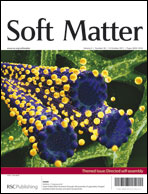Magnetic field directed assembly of two-dimensional fractal colloidal aggregates†
Abstract
The anisotropy of dipolar interactions can sometimes be a hindrance when assembling colloids, as it limits the diversity of structures that can be manufactured. Here we demonstrate that a mixture of paramagnetic and diamagnetic colloids in a ferrofluid can be used to create a variety of fractal aggregates in the presence of a field. These aggregates exhibit growth both parallel and perpendicular to the field, a distinct departure from the linear chains that are typical of dipolar

- This article is part of the themed collection: Directed self-assembly

 Please wait while we load your content...
Please wait while we load your content...